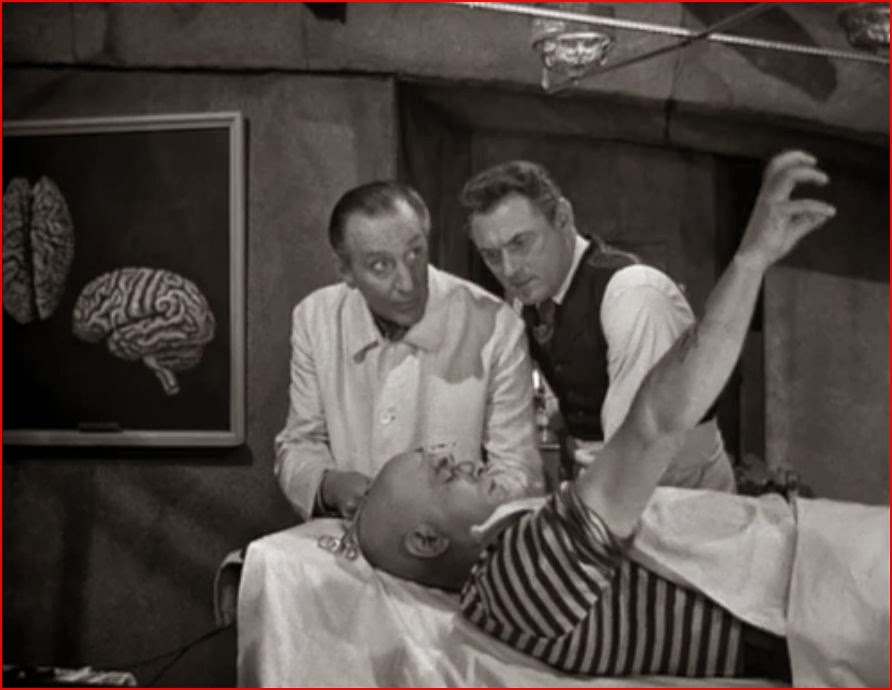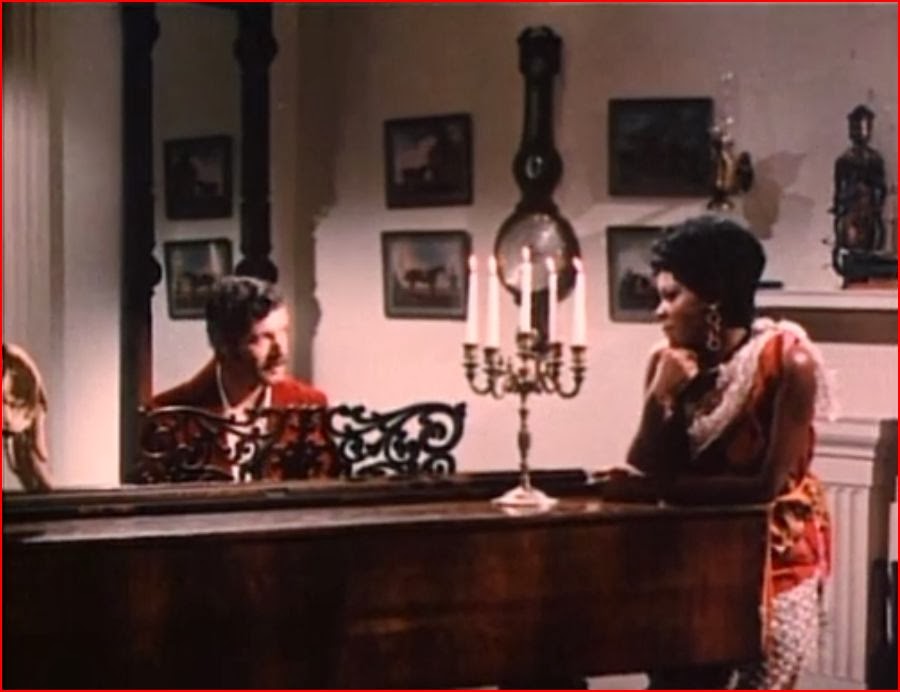 I
I could understand someone wanting to make a movie in the style or spirit of Ed Wood in our time, after his posthumous canonization as a cinematic outsider artist and long after he made the films that made his name. What's harder to fathom is someone wanting to make a film in the style or spirit of Ed Wood back in 1956, when Wood himself was toiling thanklessly behind the camera. Of course, I'm sure that comparisons with the likes of Wood were the last thing the producers of
The Black Sleep wanted at the time. Posterity makes its own judgments, however, and comparisons between Reginald Le Borg's all-star poverty row horror film and the Wood canon are not necessarily flattering to Le Borg. To be fair, the resemblances between Black Sleep and a Wood film are a matter of common influences, not of any conscious or unconscious imitation by Le Borg, producer Howard W. Koch or writer John C. Higgins. The common reference point is the poverty row horror cycle of the 1940s, the films of Monogram and PRC, though
Black Sleep is ambitious enough to beg comparisons with Val Lewton's more upscale B productions, and Le Borg himself directed for Universal toward the bitter end of that studio's great horror cycle. While Wood looks forward, adding more sci-fi elements to the poverty-row formula, Black Sleep looks backwards. It's a period piece in the manner of
House of Wax and
The Mad Magician, not to mention Lewton's
Body Snatcher and
Bedlam. But at heart it's a monster rally in the late Universal style, only with has-been horror stars as the real attractions, rather than the monsters they play.
A young doctor (Herbert Rudley) is condemned to death for a murder he did not commit, but is saved from the gallows by a fellow physician, Sir Joel Cadman (Basil Rathbone). Dr. Ramsay doesn't know that he will live; Cadman only promises him a narcotic so he won't disgrace himself. Soon, however, he awakens in his coffin to find Cadman and Udu the gypsy (Akim Tamiroff) leering at him. Cadman had administered
nind andhera, the "black sleep" drug that simulates death, and then claimed Ramsay's body. He has done this because Ramsay, a promising surgeon, has skills Cadman needs for his own experiments on the human brain. Like many a mad doctor of the 1940s, Cadman has a sick wife and wants to cure her. He must try different brain surgery techniques on live human subjects before choosing a procedure. The earlier experiments, as Ramsay discovers to his mounting horror, have not gone well.
The Black Sleep is probably best known as the last film Bela Lugosi completed before his death. It was Lugosi's comeback after his highly-publicized drying-out from drug addiction, but he was clearly cast for name value, as a matter of exploitation. His role as a mute servant -- a victim of one of Cadman's experimental surgeries -- wasn't exactly a vote of confidence in Bela by the producers. Lugosi himself admitted in an interview that even without lines it was a struggle to get through the picture due to his age and ailments. He shuffles sadly through the picture, sometimes vacantly, though there are occasional reminders that he's actually giving a performance. He uses pantomime to relay information to Rathbone, and in a few shots the indulgent director invites him to steal scenes. Here's an example:

This is supposed to be Tamiroff's scene, as you can tell from the setup, but note how Le Borg keeps the upper right corner of the screen open over Tamiroff's shoulder so we can see Bela respond to the tale the gypsy's spinning. Lugosi doesn't do much, scratching his chin every so often, but moving at all while Tamiroff talks is scene-stealing -- and the theft is more blatant now when, with no offense intended to a great character actor, no one is interested in Tamiroff when the moribund Lugosi's on the screen.

By comparison, Lon Chaney Jr. is sadly docile as another mute, though he most likely does exactly what the director asked of him. Creighton gets a weird backstory explaining how Mongo, one of the insane inmates, was once Dr. Monroe, a colleague of Cadmon's who ends up one of his experimental subjects after suffering a stroke. Cadmon actually cured Monroe's paralysis but destroyed his reason. Monroe's daughter lives at Cadmon's house and works as an assistant nurse, despite her dad's newfound urge to kill her. For some reason, only Daphne (Phyllis Stanley), Cadmon's head nurse, can control Mongo. Her voice reduces him from mania to a crestfallen sulk that probably came easily to Chaney. He'd gone mostly without dialogue in
The Indestructible Man, released in the same year, arguably a career trough for the actor. Both better and worse were in the future for him.
Mongo's troubles are more described than demonstrated, and
The Black Sleep works as if the producers thought it sufficient to show the old horror stars to jolt the audience or tickle their nostalgia bones. Once it becomes clear that Lugosi and Chaney -- not to mention Rathbone, who may have modeled his cold, stiff performance on
The Body Snatcher's Henry Daniell -- are rather boring, Le Borg takes us into Dr. Cadmon's dungeon, where our hero discovers more failed experiments. One is the very man the good doctor was accused of killing; instead, Cadmon has turned him into Tor Johnson -- I really should have screencapped the ID photo of a toupeed Tor as this character's former civilized self, as it's one of the funniest sights in the picture. Johnson can hardly make an impression, however, once Le Borg unleashes John Carradine, who has been vivisected into believing that he is the Crusader king Bohemund, awaiting news of the fall of Jerusalem. Long John was fresh from the set of
The Ten Commandments and has prophetic fury to spare here, though contemporary viewers would most likely have been reminded of the old man who'd been guarding Jack Benny's vault since the Civil War. You see, the further back in time you think you're in, the scarier rather than funnier it is. Current viewers who don't know Jack Benny will more likely believe that Le Borg sent Carradine onto the set and told him to wing it.

Everything breaks down once our hero accidentally leaves a key to the dungeon where Tor, though blind, can reach it. While Tor takes the initiative, Carradine naturally assumes leadership of the breakout; he's a king, after all! These two, along with a laughing lady covered with random tufts of hair and a disfigured dude whose makeup figured prominently in the advertising, run amok on the upper level, Carradine bopping first Daphne, then Mongo on the head in regal rage. It takes three lunatics to drag the mighty Mongo down, sans any payoff his backstory may have made you expect, while Cadmon, carrying his sick wife, takes a dive off a railing-less stairwell. Scotland Yard takes over soon afterward, and while Tamiroff and Lugosi are taken alive, the fate of the more dangerous lunatics is left unclear. Maybe someone had a sequel in mind, since Tamiroff reminds the detectives that like his feline namesake he may have nine lives. Carradine and Tor Johnson rampaging through the Victorian countryside: who wouldn't pay to see that???

While
The Black Sleep has superficial resemblances to an Ed Wood film -- Bela, Tor, cheap sets -- it lacks any of Wood's naive authenticity. Wood's films are dramatic in their incompetence and by virtue of that incompetence bear an unmistakable auteurial stamp. They are as much about the struggle behind the camera to render his vision on film or speak through his actors as they are about their stories. There's no such struggle in
The Black Sleep, and thus no drama worth seeing, not to mention no horror worth remembering. Koch, Higgins and Le Borg seem to have believed that their film could make itself if they assembled all the pieces on screen that had worked in the past. They depended on our thrill of recognition of the old stars, the old situations -- as if they thought the audience would make the film work. Technically they outclass Wood easily, but unlike him, they made a completely soulless horror film. That may sound horrific in its own right, but not in any entertaining way.
 John Carradine spent nearly a decade making a name for himself as character actor in A pictures, mainly as a contract player for Twentieth Century-Fox, but threw his reputation away to pursue a dream of classical showmanship. To raise money for a touring acting company, Carradine made himself available to Poverty Row, where he might at least get the satisfaction of occasional top billing. One early foray into this territory, Hitler's Madman, even got picked up for distribution by a major, M-G-M. Ultimately, Carradine didn't seem to care what roles he took, hitting an early career low as Bela Lugosi's stooge in Voodoo Man. Still, his name probably gave some prestige to these cheap pictures, and Edgar G. Ulmer's Bluebeard was clearly PRC's idea of a prestige picture. PRC was a company best known for Buster Crabbe westerns. Its best known films today are Ulmer's. The German-born director had a knack of making the most of very little, as Bluebeard illustrates.
John Carradine spent nearly a decade making a name for himself as character actor in A pictures, mainly as a contract player for Twentieth Century-Fox, but threw his reputation away to pursue a dream of classical showmanship. To raise money for a touring acting company, Carradine made himself available to Poverty Row, where he might at least get the satisfaction of occasional top billing. One early foray into this territory, Hitler's Madman, even got picked up for distribution by a major, M-G-M. Ultimately, Carradine didn't seem to care what roles he took, hitting an early career low as Bela Lugosi's stooge in Voodoo Man. Still, his name probably gave some prestige to these cheap pictures, and Edgar G. Ulmer's Bluebeard was clearly PRC's idea of a prestige picture. PRC was a company best known for Buster Crabbe westerns. Its best known films today are Ulmer's. The German-born director had a knack of making the most of very little, as Bluebeard illustrates. I
I 






 A
A



 S
S
 D
D
 T
T D
D





 T
T F
F





